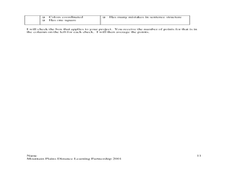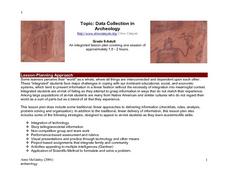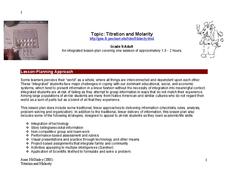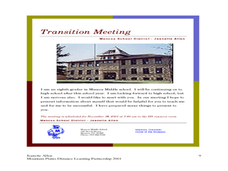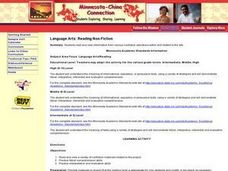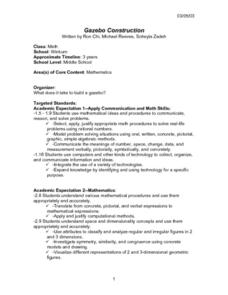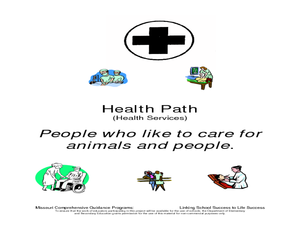Curated OER
Learning Styles Personal Brochure
Students complete an online inventory to identify their individual learning styles, strengths, and characteristics. Students use the information to create a personal brochure explaining their learning strengths and strategies to help...
Curated OER
Quilt Squares
Students research the history of the quilt in American History and view a PowerPoint Presentation. They create a quilt square with colored paper using polygons, transformations, rotations, and reflections on the computer and on a...
Curated OER
Titration and Molarity
High schoolers are introduced to the concepts of molarity and titration. As a class, they develop a list of the correct steps they need to follow to create a specific concentration of a solution. They design and complete an experiment...
Curated OER
How Atoms Work
Students analyze the way atoms function and how they combine to form molecules and various compounds. Using a software program, they create a diagram of an atom and write a summary about their functions. They complete a worksheet and...
Curated OER
Data Collection in Archaeology
Pupils research different types of rock art and categorize it into basic groups, classify Powerpoint Images according to interpretation, enter findings into Access template, and interpret results after comparing information with rest of...
Curated OER
A Fortnight of Furlongs
Middle schoolers perform a webquest to research information about the horse industry. They look at economic and the cultural impact of the industry on Central Kentucky and then create a group presentation that addresses all essential...
Curated OER
How Atoms Work
Young scholars explore the concept of atoms and how they combine to form molecules and compounds. In pairs, they read an article on how atoms work and discuss the main points. They draw atoms and write a paragraph about their elements.
Curated OER
Titration and Molarity
Young scholars investigate the concept of molarity and its relationship to the concentration of a solution. After mixing chemical solutions, they calculate how many moles of acid and base should be in each solution. They record their...
Curated OER
Math, Chemistry, and Food
Learners explore the effects of chemical reactions when cooking. Using the Internet, they research enzymes and then mix jello. They examine their results and test enzyme activity by adding pineapple to the jello. Finally, they test...
Curated OER
Dream Catchers
Students create Native American dream catchers to represent the Native American culture. After reading and discussing the origin of the Dream cather, they begin to construct their dream catchers using wire hoops, thread, beads, and...
Curated OER
Building A Topographic Model
Students visualize, in three dimensions, features represented by contour lines on a topographic map. They see that the different elevations shown on a two dimensional topographic map can be used to build a 3-D model.
Curated OER
Case of the Missing Cookies
Students imagine they are a detective who has been asked to solve the theft of cookies from a jar in the student cafeteria. Students practice using the steps of the scientific method to solve the crime. Finally, students write a detailed...
Curated OER
Using Math to Draw the Mayflower
Third graders access information from a website about the Pilgrims trip on the Mayflower and discuss the number of people on the ship and the time they spent on the ship. They draw, label and measure the Mayflower to perspective.
Curated OER
Flyer
Students create a flyer used to announce a transition meeting for the individual student as he/she enters high school. Students summarize the purpose of the meeting, remind the teachers of the meeting's date, and then distribute it to...
Curated OER
Language Arts: Reading Non-Fiction
Learners read and view information sent from seven high school students who travel to China. The daily reports that they send back to the weblog section of the site should be of high interest to learners in Minnesota.
Curated OER
Getting acquainted with a librarian and the research process
Middle schoolers brainstorm ideas about a librarian and their responsiblities and abilities to assist them then they complete an assignment tracking form in class. They record and reflect on information seeking activity then discuss...
Curated OER
Gazebo Construction
Students create and give oral proposals for the construction of a gazebo using a blueprint created with Geometer's Sketchpad. They then build a gazebo model using the blueprints created and provide evidence why it should be selected for...
Curated OER
How Do They Do That?
Third graders explore different careers by discussing which community helpers might be considered local heroes. In this career exploration instructional activity, 3rd graders work in small groups to discuss why certain people are...
Curated OER
Encouraging Writing Through Combined Photos
Students practice writing skills through using photography to help create a writing prompt. They investigate how images can be used to create new ones that related to each other. This is similar to making a collage except now the images...
Curated OER
Minnesota-China Connections: Writing Prompts
Students write a short essay in response to a writing prompt related to a theme or issue raised within the Minnesota-China Connection Web site.
Curated OER
Gainging Perspective
Seventh graders examine and evaluate different perspectives of human and wolf interactions. They develop a conclusion based on research through the use of electronic resources.
Curated OER
Our Class
Pupils discuss what they expect out of their education. After reading a story, they answer comprehension questions and match the meaning of the word to the vocabulary word. To end the lesson, they write a story about a time in which...
Curated OER
Compare and Contrast Culture
Fifth graders compare and contrast the cultures of American culture with that of the other cultures of North America. Using traditional and Internet research, 5th graders gather data on one element of culture for comparison. Data...
Curated OER
Same and Different
Young scholars explore similarities and differences. They name ways they are alike and different from their peers.



